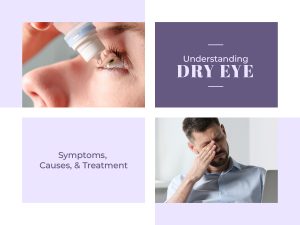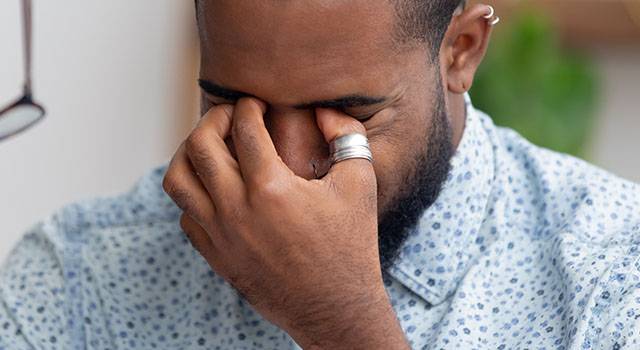Did you know that dry eye syndrome is a common eye condition that affects millions of people worldwide? It occurs when the eyes do not produce enough tears or when the tears evaporate too quickly, resulting in insufficient lubrication of the eye surface. Explore the symptoms, causes, and various treatment options available for dry eyes with Solomon Eye Associates, and protect your vision against dry eyes.
Are you struggling with dry eye? Book an appointment with Solomon Eye Associates to manage the condition and find relief.
Symptoms of Dry Eye
 Dry eye can manifest in various ways, and the severity of symptoms may vary from person to person. Some common signs and symptoms include:
Dry eye can manifest in various ways, and the severity of symptoms may vary from person to person. Some common signs and symptoms include:
- Persistent dryness or a feeling of grittiness in the eyes
- Redness and irritation
- Itching or a burning sensation
- Excessive tearing (as a reflex response to dryness)
- Blurred vision or sensitivity to light
- Eye fatigue, especially during activities that require prolonged visual attention (e.g., reading or computer work)
Causes of Dry Eye
Several factors can contribute to the development of dry eye syndrome. Some of the most common causes include:
- Aging: As we age, tear production tends to decrease, leading to an increased risk of dry eye.
- Environmental factors: Exposure to dry or windy climates, air conditioning, and heating systems can evaporate tears more rapidly, exacerbating dry eye symptoms.
- Digital eye strain: Extended periods of staring at digital screens can cause decreased blinking, leading to faster tear evaporation and dryness.
- Hormonal changes: Women undergoing menopause or hormonal fluctuations may experience dry eye due to hormonal imbalances.
- Medical conditions: Dry eye can be a symptom of various medical conditions such as Sjögren's syndrome, rheumatoid arthritis, diabetes, or thyroid disorders.
- Medications: Certain medications, such as antihistamines, decongestants, antidepressants, and hormone replacement therapy, can contribute to dry eye.
Treatment Options for Dry Eye
Fortunately, there are several treatment options available to alleviate the discomfort associated with dry eye. The choice of treatment depends on the severity and underlying cause of the condition. Here are some common approaches:
- Artificial Tears: Over-the-counter artificial tear drops and ointments can provide temporary relief by lubricating the eyes and replenishing moisture. Preservative-free formulations are recommended for those with more severe symptoms.
- Lifestyle Modifications: Simple changes in daily habits can make a significant difference. This includes taking regular breaks during screen time, positioning computer screens at eye level, and using a humidifier to add moisture to indoor air.
- Prescription Medications: In certain cases, your eye doctor may prescribe medicated eye drops to reduce inflammation and increase tear production.
- Punctal Plugs: These small, silicone plugs are inserted into the tear ducts to block the drainage of tears, allowing them to stay on the surface of the eyes for a longer period. This helps in maintaining moisture and reducing dryness.
- Intense Pulsed Light (IPL) Therapy: This innovative treatment involves using pulses of light to stimulate the meibomian glands, which produce the oily component of tears. By improving the function of these glands, IPL therapy can alleviate dry eye symptoms.
Dry eye syndrome can impact your quality of life, but with the right treatment approach, relief is possible. Consult the eye care professionals at Solomon Eye Associates if you are experiencing any symptoms of dry eye. Whether through artificial tears, lifestyle modifications, medications, or more advanced therapies, we can help manage and alleviate your dry eye symptoms effectively.

